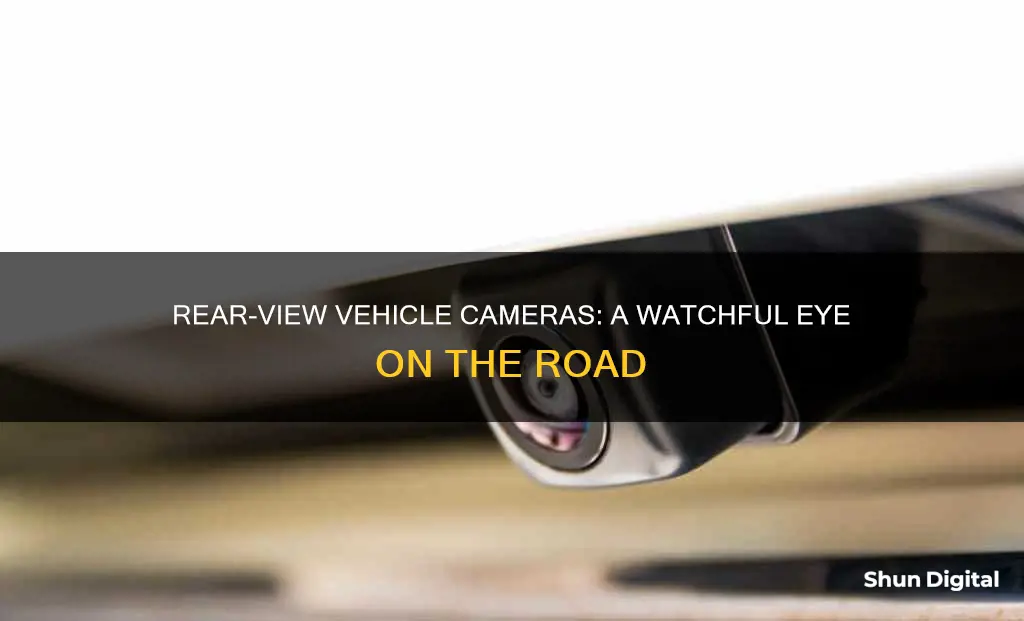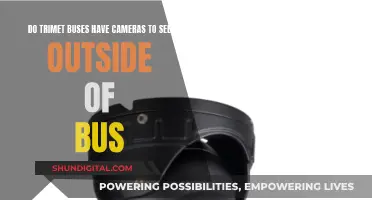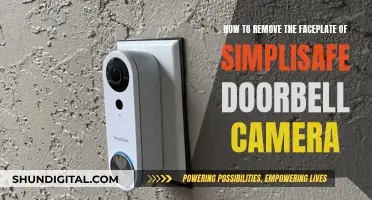
Backup cameras, also known as reversing or rear-view cameras, are now standard in new cars. They are designed to aid reversing and reduce the rear blind spot, which has been described as a killing zone due to the number of accidents it contributes to.
Backup cameras are typically mounted on the rear of a vehicle, pointed backward, and connected to the head unit display or rearview mirror. They can be wired or wireless, and some simulate a bird's-eye view of the vehicle and its surroundings.
Aftermarket options are available for older vehicles, and there are also cameras designed specifically for large vehicles such as RVs and trailers.
| Characteristics | Values |
|---|---|
| Name | Backup camera, reversing camera, rear-view camera |
| Purpose | Aid reversing, reduce rear blind spot |
| Image | Horizontally flipped to produce a mirror image |
| Camera angle | Wide-angle or fish-eye lens |
| Camera direction | Pointed at a downward angle |
| Connection | Wired or wireless |
| Display | Dashboard screen, rearview mirror, or separate monitor |
| Guidelines | Grid or parking lines to aid driver |
| Variants | Aftermarket additions, large vehicle systems, wireless, built-in audio intercoms, night vision cameras, portable or semi-permanent all-in-one camera systems, license-plate-frame versions, custom cameras |
What You'll Learn

Backup cameras are now standard in new vehicles
Backup cameras, also known as reversing or rear-view cameras, are now standard in all new vehicles sold in the US and Canada. This is because, in 2018, the US Department of Transportation mandated that every car coming off a production line must feature a backup camera. This was also regulated by law in Canada in the same year.
Backup cameras are video cameras attached to the rear of a vehicle, designed to aid in reversing and reduce the rear blind spot. This blind spot has been described as a "killing zone" due to the number of accidents it has contributed to.
The history of backup cameras
The first backup camera was used in the 1956 Buick Centurion concept car, which was presented in January 1956 at the General Motors Motorama. The vehicle had a rear-mounted television camera that sent images to a TV screen on the dashboard in place of the rear-view mirror.
In 1972, the Volvo Experimental Safety Car (VESC) also had a backup camera, but this feature did not make it into the subsequent Volvo 240 model.
The first production car to incorporate a backup camera was the 1991 Toyota Soarer Limited (UZZ31 and UZZ32), which was only available in Japan. However, this system was discontinued in 1997.
Backup cameras are typically connected to the vehicle's head unit display and are wired to automatically activate when the transmission is set to reverse. They usually have a wide-angle or fish-eye lens, which allows the camera to see an uninterrupted horizontal path from one rear corner to the other. The camera is also typically pointed at a downward angle to view potential obstacles on the ground.
Different types of backup cameras
There are several different types of backup cameras available on the market, including:
- Aftermarket additions: These can be added to vehicles that do not have factory-fitted systems and are available in wired and wireless versions.
- Large vehicle systems: For large vehicles such as motorhomes, camera systems with built-in servomechanisms allow the driver to remotely pan and tilt the camera.
- Wireless backup cameras: These come with a wireless camera and receiver, making them easier and cheaper to install.
- Built-in audio intercoms: Used in addition to the camera system for communicating with a spotter outside the vehicle when backing large trailers or launching boats.
- Night vision cameras: These use a series of infrared lights for backing up in the dark when the vehicle's white reverse lights are insufficient.
- Portable or semi-permanent all-in-one camera systems: Also known as dashboard or dash cameras, these are typically sold for vehicles that don't have displays permanently installed in the dashboard.
- License-plate-frame versions: These permit installation without any permanent vehicle modifications.
- Custom cameras: Brake light cameras combine a camera with brake light functionality. Some backup cameras also use LEDs surrounding the camera lens to illuminate the surroundings while in use.
Are You Being Watched? Detect Hidden Cameras
You may want to see also

Aftermarket options are available for older vehicles
Aftermarket backup cameras can be added to vehicles that do not come with factory-fitted systems. They are available in both wired and wireless versions. Wired cameras are hooked to output screens with wires, which means the connection is stronger, but professional installation may be required. Wireless cameras are easy to install since there are no wires or cables connecting the camera to the monitor. However, the connection may be spotty, especially in bad weather.
When choosing an aftermarket backup camera, consider the following:
- Installation: Some backup cameras use a simple suction mount for installation, while others may require hardwiring or professional installation.
- Vehicle type: Some backup cameras may only be equipped to work with certain types of vehicles, like sedans or trucks.
- Viewing angle: The larger your vehicle, the wider the viewing angle should be.
- Price: Backup cameras vary greatly in price, so consider your budget when making a purchase.
- Auto-Vox CS2 Backup Camera: This camera provides a clear picture and offers huge flexibility, all at an affordable price. It has a 4.3-inch screen and a 110-degree viewing angle.
- ERapta ERT01 Backup Camera: This wired camera is adjustable to the height of your vehicle and provides a 149-degree angle view. It has eight incorporated LED lights for easy projection in the dark and is IP69 waterproof.
- Furrion Vision S Wireless Backup System: This system uses a long-range 2.4GHz signal and has a built-in microphone with sound and motion detection to keep your RV safe. It has a 4.3-inch screen and a 180-degree viewing angle.
- LeeKooLuu LK3 Backup Camera: This camera has a 150-degree angle of view and six white LED lights to provide visibility at night. It has a 4.3-inch LCD screen and is IP69 waterproof.
Viewing FLIR Camera Clips: A Step-by-Step Guide
You may want to see also

Wired vs wireless cameras: pros and cons
Yes, there are vehicle cameras that watch the rear. These are called backup cameras, reversing cameras, or rear-view cameras. They are designed to aid in reversing and reduce the rear blind spot, which has been described as a "killing zone" due to the accidents it contributes to.
Backup cameras come in both wired and wireless versions. Here are the pros and cons of each type:
Wired Cameras:
Pros:
- Stable connection: Wired cameras are plugged directly into the network, providing more consistent and stable data transmission and communication.
- Constant power: Wired cameras receive constant power through electrical outlets or Power over Ethernet (PoE) cables, ensuring the camera keeps running as long as the electrical grid and building infrastructure are intact.
- Cutting-edge technology: While not universal, wired cameras can have advanced capabilities and modern features like remote viewing from mobile devices.
Cons:
- Difficult installation: Wired cameras require running wires and logistical considerations, limiting where they can be placed and making the installation process more complex and time-consuming.
- Less flexible: Once installed, wired cameras are typically not moved due to their tethered nature, reducing flexibility if the location is renovated or if new constructions block the camera's visibility.
Wireless Cameras:
Pros:
- Ease of installation: Wireless cameras can be quickly and easily installed without the need for running wires, making them suitable for temporary deployments or provisional use cases.
- Portability: Wireless cameras can be placed almost anywhere, even in areas without an electrical power supply, making them ideal for events or locations with changing conditions.
- Flexibility: Wireless cameras can be easily moved and redeployed to different locations, providing flexibility in surveillance strategies.
Cons:
- Connectivity: Wireless cameras rely on wireless signals, which may be less stable and reliable than wired connections, especially in remote areas or places with unreliable Wi-Fi.
- Cybersecurity: While modern wireless cameras can be secure, they have an extra point of vulnerability through Internet connectivity, requiring additional safeguards against cyberattacks.
- Power failures: Wireless cameras that are battery-powered or solar-powered may be prone to losing charge or facing limitations in continuous recording capability.
Both wired and wireless vehicle cameras have their advantages and drawbacks. Wired cameras offer stability and constant power but may be more challenging to install and less flexible. On the other hand, wireless cameras provide ease of installation, portability, and flexibility but may have connectivity and cybersecurity concerns, as well as power limitations. The choice between the two depends on specific requirements, such as the location, surveillance objectives, and the need for constant connectivity and cybersecurity.
Exiting the Watchful Eye of Cameras: A Guide to Evading Surveillance
You may want to see also

Installation: DIY or professional?
Installing a rear-view camera can be a complex process, and you may want to consider hiring a professional to do it. However, if you have some technical know-how and feel confident, it is possible to install one yourself.
The first step is to purchase the necessary equipment, including the camera, monitor, and any cables or connectors that may be required. The camera can be mounted on or behind the license plate, and the monitor can be either an external device mounted on the windshield or an internal device that replaces the existing rear-view mirror.
The next step is to connect the camera and monitor. This may involve drilling a small hole to run the cables and then connecting the camera to the reverse light wires. The monitor can then be powered by connecting it to the fuse box or cigarette lighter adaptor.
Finally, the camera and monitor need to be tested to ensure they are working correctly. This can be done by testing the system in a safe area and checking the image quality and functionality.
While it is possible to install a rear-view camera yourself, it is important to note that incorrect installation can lead to malfunctions. It is recommended to seek professional help if you are unsure about any part of the process. Some camera manufacturers also offer installation services or can provide guidance on the correct installation process.
Overall, whether you choose to install a rear-view camera yourself or hire a professional, it is important to ensure that the camera is properly installed and functioning correctly to provide the desired safety benefits.
Building a Pinhole Camera to View an Eclipse
You may want to see also

Camera features: night vision, wide-angle lens, etc
When it comes to vehicle cameras, there are a variety of features that can enhance your driving experience and improve safety. Here are some key camera features to consider:
Night Vision
Night vision is an essential feature for driving in low-light conditions or complete darkness. It allows the camera to capture clear footage, helping you navigate and avoid obstacles when backing up at night or in dimly lit areas. This feature is particularly useful for those who frequently drive in areas with limited lighting, such as rural roads or unlit parking lots.
Wide-Angle Lens
A wide-angle lens provides a broader field of view, reducing blind spots and enhancing your peripheral vision. This feature is especially valuable when manoeuvring in tight spaces or reversing, as it allows you to see more of the area surrounding your vehicle. Wide-angle lenses typically offer a viewing angle of around 110 to 180 degrees, giving you a more comprehensive view of your surroundings.
High-Definition Resolution
High-definition (HD) resolution, such as 1080p or higher, ensures that the camera captures clear and detailed footage. This is crucial for identifying potential hazards, reading license plates, and getting a precise view of your surroundings. HD resolution also improves the overall driving experience, providing a sharper and more defined image on your display.
Waterproof Design
A waterproof or water-resistant camera is designed to withstand the elements, protecting it from rain, snow, and other environmental factors. This feature ensures that your camera remains functional and reliable even in harsh weather conditions, providing you with uninterrupted visibility and peace of mind during your drives.
Motion Detection
Motion detection is a valuable feature that automatically detects moving objects within the camera's field of view. This can be particularly useful for security purposes, as it can alert you to potential hazards or unwanted intruders near your vehicle. Additionally, motion detection can be used to optimise recording, triggering the camera to start recording only when motion is detected, conserving storage space and battery life.
Parking Guidelines
Parking guidelines or distance scale lines are superimposed on the camera's display, providing you with a visual reference for distance and manoeuvring. These guidelines assist you in judging distances accurately when reversing or parking, making it easier to avoid collisions with obstacles or other vehicles.
Wireless Connectivity
Wireless connectivity eliminates the need for cumbersome cables and makes installation simpler and more straightforward. Wireless cameras often utilise digital signals to transmit footage to the display, resulting in a stable and interference-free image. This feature enhances convenience and flexibility, allowing for easier installation and a neater overall setup.
By incorporating these features into your vehicle camera, you can enhance your driving experience, improve safety, and gain greater peace of mind while on the road.
Stop Neighbors Spying: Block Their Camera Views
You may want to see also
Frequently asked questions
A backup camera is a video camera that is attached to the rear of a vehicle to aid in reversing and reduce the rear blind spot. It is also known as a reversing camera or rear-view camera.
Installation depends on the specific model. Some backup cameras are wireless and attach to your license plate, while others may require professional installation. Refer to the manufacturer's instructions for the installation process.
The best backup cameras provide high-resolution imaging, a wide field of view, night vision capabilities, reliable connectivity, and an easy-to-use interface. Additional features such as parking guidelines or collision warnings might be included in some models.
The best backup camera depends on your specific needs and budget. Some top-rated options include the Auto-Vox CS2, eRapta ERT01, Furrion Vision S Wireless, LeeKooLuu LK3, and Yada RoadCam 4K UHD.
Backup cameras are legal and mandated on all new vehicles sold in the US. However, if you are retrofitting an older car, check your local laws to ensure installation and operation comply with regulations.







